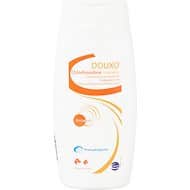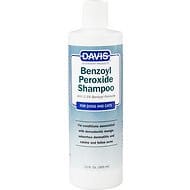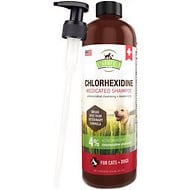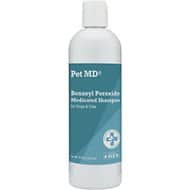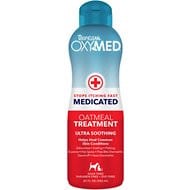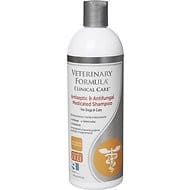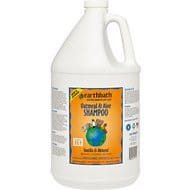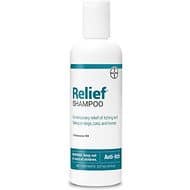Contents
If you’re a fan of pet transformations and heroic adoption stories, you’ve probably seen the havoc mange can wreak on a pet. Mange is an incredibly itchy skin condition that can take over your cat’s body, leaving him with extremely irritated skin and little if any hair. Mange is the name given to mite infestations which are more common in feral and neglected cats but can also affect housecats if they come into contact with wildlife or outdoor cats.
In many ways, mange affects your cat in a similar way to fleas. Both infestations have the potential to make your cat very itchy, causing him to scratch and overgroom which opens him up to the risk of secondary skin infections. Mange infestations can become very severe in a short period of time, so it’s important to recognize the signs and seek treatment as soon as you can.
In this article, we’ll explore the subject of mange in pets to learn how to identify it and how to treat mange in cats. We’ll talk about the two different types of mange and how using a medicated shampoo could help ease your cat’s symptoms. You’ll also see our top picks for the best cat mange shampoo.
What Is The Best Cat Shampoo for Mange?
- Duoxo Chlorhexidine PS Dog & Cat Shampoo
- Davis Benzoyl Peroxide Dog & Cat Shampoo
- MiconaHex+Triz Shampoo for Dogs & Cats
- Strawfield Pets Chlorhexidine Medicated Shampoo
- PetMD Benzoyl Peroxide Dog & Cat Shampoo
- TropiClean OxyMed Medicated Anti-Itch Oatmeal
- Veterinary Formula Clinical Care Antiseptic & Antifungal
- Earthbath Oatmeal & Aloe Dog & Cat Shampoo
- Relief Shampoo with Pramoxine & Colloidal Oatmeal
What is Mange?
The word mange is just another name for a mite infestation. The two most common types of mange mites in cats are Demodex cati (black mange) and Scabies sarcoptes (red mange). Cheyletiella is another type of mite sometimes found in cats but, these mites live on the outer layer of skin rather than burrowing into it, so the condition isn’t usually quite so severe.
Named after the two most common types of mites seen in cats, mange is typically seen in one of two types: demodectic mange and sarcoptic mange.
Mange mites are similar to fleas in that they are also parasites that live on the cat’s skin. The primary difference is that while fleas simply feed on your cat’s blood and lay their eggs on his skin, mites burrow into your cat’s skin to lay their eggs. This leads to symptoms similar to those of a flea infestation, but they can become much more severe.
Here are some of the signs of mange in cats:
- Itching and excessive scratching
- Greasy skin and matted coat
- Red and inflamed skin
- Scaling on the face, neck, and eyelids
- Discoloration of the skin
- Excessive licking and grooming
- Patches of progressive hair loss
- Restless behavior
How to Treat Mange in Cats
If you suspect that your cat has mange, you should take him to the veterinarian right away. Diagnosis of mange usually involves skin scrapings to observe the mites under a microscope. This will help your veterinarian identify the type of mite to determine the best course of treatment. Demodex cati mites are cigar-shaped with stubby legs while Scabies sarcoptes mites are oval-shaped.
Here are some of the steps involved in treating mange in cats:
- Isolating your cat to prevent it from spreading the infection to other pets.
- Topical or injectable medication to kill the mites.
- Medicated shampoo to help kill the mites and relieve symptoms.
- Antibacterial shampoo to treat related skin symptoms and reduce inflammation.
Now that you know the basics about mange, you’re ready to start shopping for cat mange shampoo. Remember, all cats are prone to manage, so it pays to be able to recognize the symptoms. Malnourished and immunocompromised cats, however, have the highest risk. As long as your cat stays indoors and you use flea and tick protection, you shouldn’t have to worry too much about mange.
The Best Cat Shampoo for Mange
If you’re wondering how to treat mange in cats, your veterinarian is the best person to answer that question. Your cat’s treatment will be determined by the type of mange he has and the severity of the infestation. That being said, medicated shampoo will likely be part of his treatment plan to help relieve itching, repair the skin, and speed the healing process.
Here are our top picks for the best cat shampoo for mange:
| Our 2024 Picks: Best Cat Shampoo for Mange | |||
Duoxo Chlorhexidine PS Dog & Cat Shampoo
|
CHECK PRICE | ||
Davis Benzoyl Peroxide Dog & Cat Shampoo
|
CHECK PRICE | ||
MiconaHex+Triz Shampoo for Dogs & Cats
|
CHECK PRICE | ||
Strawfield Pets Chlorhexidine Medicated Shampoo
|
CHECK PRICE | ||
PetMD Benzoyl Peroxide Dog & Cat Shampoo
|
CHECK PRICE | ||
TropiClean OxyMed Medicated Anti-Itch Oatmeal Shampoo
|
CHECK PRICE | ||
Veterinary Formula Clinical Care Antiseptic & Antifungal
|
CHECK PRICE | ||
Earthbath Oatmeal & Aloe Dog & Cat Shampoo
|
CHECK PRICE | ||
Relief Shampoo with Pramoxine & Colloidal Oatmeal
|
CHECK PRICE | ||
Duoxo Chlorhexidine PS Dog & Cat Shampoo
Formulated to treat a wide variety of superficial and severe skin issues, this Duoxo Chlorhexidine PS Dog & Cat Shampoo is a great choice for cat mange shampoo. This formula features chlorhexidine as the primary active ingredient with climbazole to help control bacteria and fungi from secondary infections. It also contains lipacid to restore the skin’s natural protective barrier, helping reduce moisture loss and inflammation. Phytosphingosine is also included for its anti-inflammatory and anti-itching benefits.
Pros: Improved management of skin conditions, relieves inflammation and itching
Cons: May not lather as well as some shampoos, contains some artificial fragrance
Davis Benzoyl Peroxide Dog & Cat Shampoo
In order for a shampoo to work, the active ingredients need to be able to penetrate the skin. This Davis Benzoyl Peroxide Dog & Cat Shampoo is formulated to penetrate the skin better than other shampoos because it contains a 1-to-3 micron-sized benzoyl peroxide powder. This powder is suspended in a deep cleansing and moisturizing base that opens the flushes the hair follicles to speed the healing process. This shampoo also contains natural moisturizing agents to hydrate the skin, reducing dryness and irritation. It also works well as a degreaser for cats with severe coat problems.
Pros: Better skin penetration than other formulas, deep cleansing and moisturizing action
Cons: May require repeated applications, contains some artificial fragrance
MiconaHex+Triz Shampoo for Dogs & Cats
Formulated with a duo of powerful active ingredients, this MiconaHex+Triz Shampoo for Dogs & Cats is a great option in cat mange shampoo. This medicated shampoo is designed to fight everything from dandruff and ringworms to fungal and bacterial infections. It contains ceramides to help moisturize, repair, and restore dry and damaged skin – plus, it is free from artificial fragrance. Simply apply to wet fur and work into a lather before letting soak for 5 to 10 minutes and rinsing clean.
Pros: Duo of active ingredients, contains ceramides to moisturize and repair the skin
Cons: May require repeated applications
Strawfield Pets Chlorhexidine Medicated Shampoo
This medicated shampoo features chlorhexidine as the active ingredient in a powerful 4% concentration. Strawfield Pets Chlorhexidine Medicated Shampoo is designed to deliver fast itch relief caused by everything from ringworm and mange to dermatitis and pyoderma. This shampoo is made with a no-sting formula that delivers a soothing sensation to relieve itching and irritation while leaving behind a light, fresh scent. It can also be used to treat insect bites.
Pros: Powerful 4% concentration of chlorhexidine, relieves itching and irritation quickly
Cons: Contains some added fragrance, may not lather as well as some shampoos
PetMD Benzoyl Peroxide Dog & Cat Shampoo
For gentle but powerful itch relief, consider this PetMD Benzoyl Peroxide Dog & Cat Shampoo. This shampoo is a soap-free formulation made with both benzoyl peroxide and salicylic acid to reduce scaling. In doing so, it relieves itching and painful irritation caused by a variety of skin conditions including mange. This shampoo is safe to use on the entire body and it gets deep into the pores, flushing the hair follicles to relieve irritation, inflammation, and itching at the source.
Pros: Relieves itching and irritation, flushes the pores, soap-free formula
Cons: May require repeated applications, some users found the scent too strong
Other Recommended Cat Shampoos
Depending on the type and severity of your cat’s mange infestation, your veterinarian may recommend oral or topical medications to kill the mites. While completing this course of treatment, you might also want to think about bathing your cat with shampoo designed to relieve itching and speed skin repair.
TropiClean OxyMed Medicated Anti-Itch Oatmeal Shampoo
If your cat’s skin is dry and flaky, this TropiClean OxyMed Medicated Anti-Itch Oatmeal Shampoo could help. Gentle enough for daily use, this shampoo is a great option for itch relief that won’t interfere with your cat’s other treatments. It contains natural salicylic acid to eliminate flaking and scaling as well as oatmeal, tea tree, and vitamin E to reduce swelling and promote healing. This shampoo is made with gentle coconut-based cleansers and it is soap-free so it won’t affect flea and tick treatments.
Veterinary Formula Clinical Care Antiseptic & Antifungal Shampoo
Serious itching and scratching can open your cat up to fungal skin infections and make the issues caused by his mange worse. If you’re treating your cat’s mange with oral medications, this Veterinary Formula Clinical Care Antiseptic & Antifungal Shampoo might help address the skin issues he’s experiencing while you get the infestation under control. This formula offers antibacterial, antifungal, and antimicrobial benefits with aloe vera to soothe the skin and speed healing.
Earthbath Oatmeal & Aloe Dog & Cat Shampoo
When your cat’s skin is already irritated, you may want to avoid using products that contain harsh ingredients. This Earthbath Oatmeal & Aloe Dog & Cat Shampoo features a natural formulation designed to remoisturize, heal, and soothe your cat’s dry and itchy skin. This shampoo is soap-free, enriched with oatmeal and organic aloe to relieve inflammation and itching. It is completely free from phosphates and parabens, plus it has a pleasant vanilla almond scent.
Relief Shampoo with Pramoxine & Colloidal Oatmeal
Manage your cat’s skin irritation with this Relief Shampoo with Pramoxine & Colloidal Oatmeal. This soap-free formula gently cleanses and moisturizes the skin to support its natural protective barrier. This shampoo contains gentle surfactants, humectants, and conditioners to support healthy skin because healthy and nourished skin is less prone to irritation and inflammation. Formulated to relieve itching from flea and insect bites, this shampoo is perfect for cats with dry and sensitive skin.
Frequently Asked Questions
- What does mange look like in a cat? In many ways, mange looks like a flea infestation. Fleas live on your cat’s skin, feeding on his blood and laying their eggs along the hair follicles. The difference with mange is that the mites actually burrow into the skin to lay their eggs. As you can imagine, this causes a higher degree of skin irritation and itching. The signs of sarcoptic and demodectic mange in cats are similar – they include itching and scratching, skin inflammation, scaly patches of skin, hair loss, and restless behavior.
- Can you catch mange from a cat? Mange is extremely contagious, and your cat can catch it from other animals, including wildlife. This condition is particularly common among feral cat colonies, though any outdoor cat can contract it. The good news for you is that the species of mites that affect cats do not affect humans. Sarcoptes scabiei hominis are the mites that cause scabies in humans.
- How do you tell if your cat has mange or ringworm? Telling the difference between mange and ringworm in cats can be tricky. Both conditions cause changes to the skin and coat, so you’ll need to pay attention to the details to make the distinction. Mange tends to be a more widespread issue while ringworm may form lesions on a more limited area of the body. Hair loss is common to both conditions, though with mange, the hair tends to break off at the base. This results in the appearance of more complete hair loss whereas with ringworm the hair tends to break partway down the shaft.
- How long does it take to treat mange? When it comes to treating sarcoptic and demodectic mange in cats, prompt treatment is essential. The longer your cat goes without treatment, the more severe his symptoms will become and the longer it will take him to recover. For mange in cats, treatment at home depends on the type of mite involved and the severity of the infestation. In some cases, cats recover in as little as 6 weeks. More severe infestations may take longer.
As much as you might like to give your cat the chance to explore the great outdoors, it may not be worth the risk. Not only are outdoor cats more prone to injury and predation but letting your cat outside puts him at risk for mange.
Though easily preventable, mange can become very severe and may cause serious damage to your cat’s skin and coat. If you’re worried that your cat has developed mange, talk to your veterinarian and consider bathing him with one of our recommended cat shampoos for mange above.


